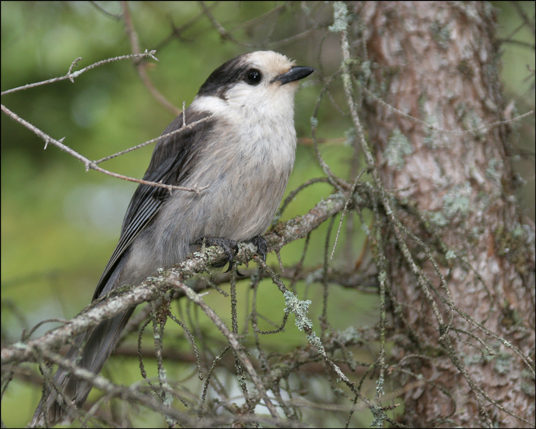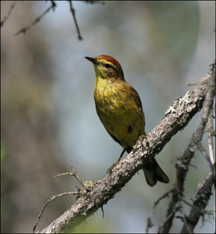Birding Festivals in the Adirondacks:
2013 Great Adirondack Birding Celebration
31 May - 2 June 2013
Field Trip Descriptions
 Boreal Birds of the Adirondacks: Gray Jay. Bloomingdale Bog. Photo by Larry Master. www.masterimages.org
Boreal Birds of the Adirondacks: Gray Jay. Bloomingdale Bog. Photo by Larry Master. www.masterimages.org
Birding by Ear at the Paul Smith’s College Visitor Interpretive Center (VIC)
Trip Description: Designated an Important Bird Area by the American Bird Conservancy, the Paul Smith’s VIC property contains every habitat type found in the Adirondack Park with the exception of alpine vegetation. Included on the property is a 60-acre marsh, five ponds, several brooks and swamps, bogs, fens, and varied forest types, most notably northern boreal forest. The 14-mile trail system traverses a variety of habitats with extensive boardwalks through wetland ecosystems. Common sightings at the Paul Smiths VIC include: Wood Duck, American Black Duck, Great Blue Heron, American Bittern, Olive-sided Flycatcher, Yellow-bellied Flycatcher and Black-backed Woodpecker. Warblers include (Yellow) Palm Warbler, Northern Parula, Blackburnian Warbler, Black-throated Blue Warbler, Black-throated Green Warbler, and Nashville Warbler. Other sightings may include Gray Jay, Boreal Chickadee, and Wilson’s Snipe, Broad-winged Hawk, Hooded Merganser, and Ring-necked Duck.
Beginner Birder Workshop at the Paul Smith's College VIC
Workshop Description: You probably feed the birds in your backyard and enjoy the beauty they bring, but lately you’ve been asking yourself what the other birds are that visit the trees in your neighborhood during the spring and summer months. Well, now’s the chance to start learning those birds! Our Beginner Birder Workshop will take you step-by-step through the intricate lives of birds. Leaders will introduce field identification and song identification skills in a relaxed manner so you can fully absorb the intricacies of the lives of birds.
Birding Across the Adirondacks (Friday Only)
Trip Description: Participants leave the VIC at 9:00 AM for an all-day field trip “down the mountain” to the beautiful shoreline of Lake Champlain in search of migratory birds. This field trip will feature stops at many birding hotspots as we look at a cross-section of bird life from high elevation to low. Return to VIC at 4:00 PM. Preregistration required.
Bloomingdale Bog / Bigelow Road
 Trip Description: Bloomingdale Bog is great habitat for boreal species. The area encompasses a bog and cedar woods with sedge marsh and coniferous woods. Sightings may include: Boreal Chickadee, Gray Jay, Black-backed Woodpecker, Palm Warbler, Yellow-bellied Flycatcher, Olive-sided Flycatcher, Alder Flycatcher, Ruby-crowned Kinglet, Cape May Warbler, Bay-breasted Warbler, and Lincoln's Sparrow.
Trip Description: Bloomingdale Bog is great habitat for boreal species. The area encompasses a bog and cedar woods with sedge marsh and coniferous woods. Sightings may include: Boreal Chickadee, Gray Jay, Black-backed Woodpecker, Palm Warbler, Yellow-bellied Flycatcher, Olive-sided Flycatcher, Alder Flycatcher, Ruby-crowned Kinglet, Cape May Warbler, Bay-breasted Warbler, and Lincoln's Sparrow.
Intervale Lowlands
Trip Description: Intervale Lowlands is a 135-acre nature preserve which includes 7,500’ of frontage on the West Branch of the Ausable River in Lake Placid. With a mixture of young boreal forest, riverside shrublands, and open fields, the “preserve” is home to 15+ species of breeding warblers. The Mourning Warbler is common, and the Cape May Warbler was confirmed nesting during the last Breeding Bird Atlas and during the last two years. Also found here are six species of nesting woodpeckers (including Black-backed), Brown Thrasher, Indigo Bunting, Lincoln’s Sparrow, Alder Flycatcher, Turkey, Woodcock, Ruffed Grouse and American Bittern; Olive-sided Flycatchers and Rusty Blackbirds visit regularly. Nest boxes/platforms are put up for Ospreys, Kestrels, Bluebirds, Flickers, Hooded and Common Mergansers, Chickadees, and Barred and Saw-whet Owls. Bald Eagles fish the river on a weekly basis. Resident mammals include: Beaver (two families), Coyote, Deer, Bobcat, Otter, Fisher, and Ermine. Bear, Marten, and Red and Gray foxes visit regularly. Moose visit occasionally. Intervale Lowlands Bird Walk (3 June 2012)
Little Clear Pond for Loons
Trip Description: Little Clear Pond is a haven for common loon with crystal clear water and healthy food sources for growing loon families. Dr. Nina Schoch is a wildlife veterinarian at Biodiversity Research Institute. She coordinates their Adirondack Center for Loon Conservation in New York’s Adirondack Park. Dr. Schoch’s research has focused on using Adirondack common loons as a sentinel species to better understand the impact of environmental contaminants on aquatic ecosystems. Schoch will lead us on a graceful, and educational paddle in search of these beautiful symbols of Adirondack wilderness. Canoes will be furnished, but you may bring your own canoe or kayak for this field trip.
Madawaska Flow
 Trip Description: Madawaska has been a favored boreal birding area for a half-century or more. The area encompasses conifer forest, mixed hardwood forest, a variety of wetlands, as well as Madawaska Pond. Sightings may include: (Yellow) Palm Warbler, Lincoln's Sparrow, Sharp-shinned Hawk, Black-backed Woodpecker, Gray Jay, Boreal Chickadee, Northern Parula, Yellow-bellied Flycatcher and Olive-sided Flycatcher. As the habitat changes to white pine forest, the Brown Creeper can be found nesting behind loose bark. Madawaska Pond may have Green-winged Teal, American Bittern, and Bald Eagle. Madawaska Flow Bird Walk (3 June 2012)
Trip Description: Madawaska has been a favored boreal birding area for a half-century or more. The area encompasses conifer forest, mixed hardwood forest, a variety of wetlands, as well as Madawaska Pond. Sightings may include: (Yellow) Palm Warbler, Lincoln's Sparrow, Sharp-shinned Hawk, Black-backed Woodpecker, Gray Jay, Boreal Chickadee, Northern Parula, Yellow-bellied Flycatcher and Olive-sided Flycatcher. As the habitat changes to white pine forest, the Brown Creeper can be found nesting behind loose bark. Madawaska Pond may have Green-winged Teal, American Bittern, and Bald Eagle. Madawaska Flow Bird Walk (3 June 2012)
Spring Pond Bog
Trip Description: Participants will explore one of the largest peat land complexes in New York State. Spring Pond Bog is the second largest open expanse of peat land in New York and contains a patterned peat land with ridges (strings) and wet depressions (flarks). On this field trip, participants should see/hear most of the more common lowland boreal birds (Gray Jay, Olive-sided Flycatcher, Yellow-bellied Flycatcher, Boreal Chickadee and woodpeckers), and may see some of the less common species such as the Tennessee warbler or the Spruce Grouse. The trip includes bushwhacking in boggy areas and thick spruce/fir/tamarack stands. Wear sturdy boots, as it is often wet to very wet underfoot. No rain pants please (sound may startle certain species).
Whiteface Mountain
Trip Description: The trip will begin with a flat, easy walk around Lake Stevens Tree Trail at the Whiteface Mountain Memorial Highway toll house. Then participants will carpool up the toll road, stopping at pull-offs and searching for mountain birds. Sightings may include: Bicknell's Thrush, Blackpoll Warbler, Yellow-bellied Flycatcher and Boreal Chickadees.
Sponsored by:
Northern New York Audubon Society
Paul Smiths College
Adirondack Birding Center at the Paul Smith's College VIC
Wild Birds Unlimited
Mac's Canoe Livery
Great Adirondack Birding Celebration 2013. Field Trip Descriptions. Printable Word Version.
Great Adirondack Birding Celebration 2013. Field Trip Descriptions. Printable PDF Version.
Great Adirondack Birding Celebration 2013. Schedule of Events. Printable Word Version.
Great Adirondack Birding Celebration 2013. Schedule of Events. Printable PDF Version.
